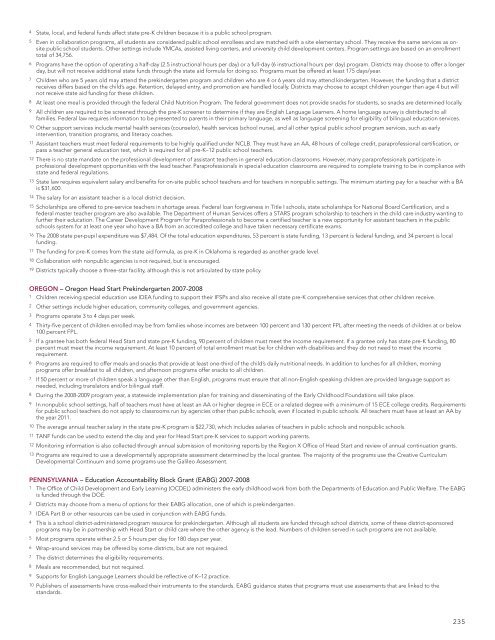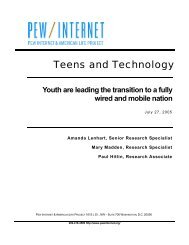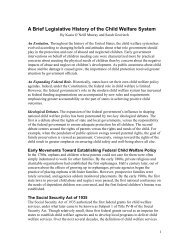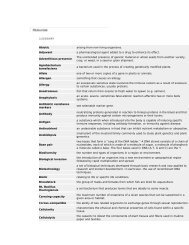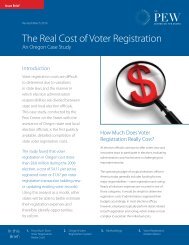Report: The State of Preschool 2008: State Preschool Yearbook
Report: The State of Preschool 2008: State Preschool Yearbook
Report: The State of Preschool 2008: State Preschool Yearbook
You also want an ePaper? Increase the reach of your titles
YUMPU automatically turns print PDFs into web optimized ePapers that Google loves.
4 <strong>State</strong>, local, and federal funds affect state pre-K children because it is a public school program.<br />
5 Even in collaboration programs, all students are considered public school enrollees and are matched with a site elementary school. <strong>The</strong>y receive the same services as onsite<br />
public school students. Other settings include YMCAs, assisted living centers, and university child development centers. Program settings are based on an enrollment<br />
total <strong>of</strong> 34,756.<br />
6 Programs have the option <strong>of</strong> operating a half-day (2.5 instructional hours per day) or a full-day (6 instructional hours per day) program. Districts may choose to <strong>of</strong>fer a longer<br />
day, but will not receive additional state funds through the state aid formula for doing so. Programs must be <strong>of</strong>fered at least 175 days/year.<br />
7 Children who are 5 years old may attend the prekindergarten program and children who are 4 or 6 years old may attend kindergarten. However, the funding that a district<br />
receives differs based on the child’s age. Retention, delayed entry, and promotion are handled locally. Districts may choose to accept children younger than age 4 but will<br />
not receive state aid funding for these children.<br />
8 At least one meal is provided through the federal Child Nutrition Program. <strong>The</strong> federal government does not provide snacks for students, so snacks are determined locally.<br />
9 All children are required to be screened through the pre-K screener to determine if they are English Language Learners. A home language survey is distributed to all<br />
families. Federal law requires information to be presented to parents in their primary language, as well as language screening for eligibility <strong>of</strong> bilingual education services.<br />
10 Other support services include mental health services (counselor), health services (school nurse), and all other typical public school program services, such as early<br />
intervention, transition programs, and literacy coaches.<br />
11 Assistant teachers must meet federal requirements to be highly qualified under NCLB. <strong>The</strong>y must have an AA, 48 hours <strong>of</strong> college credit, parapr<strong>of</strong>essional certification, or<br />
pass a teacher general education test, which is required for all pre-K–12 public school teachers.<br />
12 <strong>The</strong>re is no state mandate on the pr<strong>of</strong>essional development <strong>of</strong> assistant teachers in general education classrooms. However, many parapr<strong>of</strong>essionals participate in<br />
pr<strong>of</strong>essional development opportunities with the lead teacher. Parapr<strong>of</strong>essionals in special education classrooms are required to complete training to be in compliance with<br />
state and federal regulations.<br />
13 <strong>State</strong> law requires equivalent salary and benefits for on-site public school teachers and for teachers in nonpublic settings. <strong>The</strong> minimum starting pay for a teacher with a BA<br />
is $31,600.<br />
14 <strong>The</strong> salary for an assistant teacher is a local district decision.<br />
15 Scholarships are <strong>of</strong>fered to pre-service teachers in shortage areas. Federal loan forgiveness in Title I schools, state scholarships for National Board Certification, and a<br />
federal master teacher program are also available. <strong>The</strong> Department <strong>of</strong> Human Services <strong>of</strong>fers a STARS program scholarship to teachers in the child care industry wanting to<br />
further their education. <strong>The</strong> Career Development Program for Parapr<strong>of</strong>essionals to become a certified teacher is a new opportunity for assistant teachers in the public<br />
schools system for at least one year who have a BA from an accredited college and have taken necessary certificate exams.<br />
16 <strong>The</strong> <strong>2008</strong> state per-pupil expenditure was $7,484. Of the total education expenditures, 53 percent is state funding, 13 percent is federal funding, and 34 percent is local<br />
funding.<br />
17 <strong>The</strong> funding for pre-K comes from the state aid formula, as pre-K in Oklahoma is regarded as another grade level.<br />
18 Collaboration with nonpublic agencies is not required, but is encouraged.<br />
19 Districts typically choose a three-star facility, although this is not articulated by state policy.<br />
OREGON – Oregon Head Start Prekindergarten 2007-<strong>2008</strong><br />
1 Children receiving special education use IDEA funding to support their IFSPs and also receive all state pre-K comprehensive services that other children receive.<br />
2 Other settings include higher education, community colleges, and government agencies.<br />
3 Programs operate 3 to 4 days per week.<br />
4 Thirty-five percent <strong>of</strong> children enrolled may be from families whose incomes are between 100 percent and 130 percent FPL after meeting the needs <strong>of</strong> children at or below<br />
100 percent FPL.<br />
5 If a grantee has both federal Head Start and state pre-K funding, 90 percent <strong>of</strong> children must meet the income requirement. If a grantee only has state pre-K funding, 80<br />
percent must meet the income requirement. At least 10 percent <strong>of</strong> total enrollment must be for children with disabilities and they do not need to meet the income<br />
requirement.<br />
6 Programs are required to <strong>of</strong>fer meals and snacks that provide at least one-third <strong>of</strong> the child’s daily nutritional needs. In addition to lunches for all children, morning<br />
programs <strong>of</strong>fer breakfast to all children, and afternoon programs <strong>of</strong>fer snacks to all children.<br />
7 If 50 percent or more <strong>of</strong> children speak a language other than English, programs must ensure that all non-English speaking children are provided language support as<br />
needed, including translators and/or bilingual staff.<br />
8 During the <strong>2008</strong>-2009 program year, a statewide implementation plan for training and disseminating <strong>of</strong> the Early Childhood Foundations will take place.<br />
9 In nonpublic school settings, half <strong>of</strong> teachers must have at least an AA or higher degree in ECE or a related degree with a minimum <strong>of</strong> 15 ECE college credits. Requirements<br />
for public school teachers do not apply to classrooms run by agencies other than public schools, even if located in public schools. All teachers must have at least an AA by<br />
the year 2011.<br />
10 <strong>The</strong> average annual teacher salary in the state pre-K program is $22,730, which includes salaries <strong>of</strong> teachers in public schools and nonpublic schools.<br />
11 TANF funds can be used to extend the day and year for Head Start pre-K services to support working parents.<br />
12 Monitoring information is also collected through annual submission <strong>of</strong> monitoring reports by the Region X Office <strong>of</strong> Head Start and review <strong>of</strong> annual continuation grants.<br />
13 Programs are required to use a developmentally appropriate assessment determined by the local grantee. <strong>The</strong> majority <strong>of</strong> the programs use the Creative Curriculum<br />
Developmental Continuum and some programs use the Galileo Assessment.<br />
PENNSYLVANIA – Education Accountability Block Grant (EABG) 2007-<strong>2008</strong><br />
1 <strong>The</strong> Office <strong>of</strong> Child Development and Early Learning (OCDEL) administers the early childhood work from both the Departments <strong>of</strong> Education and Public Welfare. <strong>The</strong> EABG<br />
is funded through the DOE.<br />
2 Districts may choose from a menu <strong>of</strong> options for their EABG allocation, one <strong>of</strong> which is prekindergarten.<br />
3 IDEA Part B or other resources can be used in conjunction with EABG funds.<br />
4 This is a school district-administered program resource for prekindergarten. Although all students are funded through school districts, some <strong>of</strong> these district-sponsored<br />
programs may be in partnership with Head Start or child care where the other agency is the lead. Numbers <strong>of</strong> children served in such programs are not available.<br />
5 Most programs operate either 2.5 or 5 hours per day for 180 days per year.<br />
6 Wrap-around services may be <strong>of</strong>fered by some districts, but are not required.<br />
7 <strong>The</strong> district determines the eligibility requirements.<br />
8 Meals are recommended, but not required.<br />
9 Supports for English Language Learners should be reflective <strong>of</strong> K–12 practice.<br />
10 Publishers <strong>of</strong> assessments have cross-walked their instruments to the standards. EABG guidance states that programs must use assessments that are linked to the<br />
standards.<br />
235


